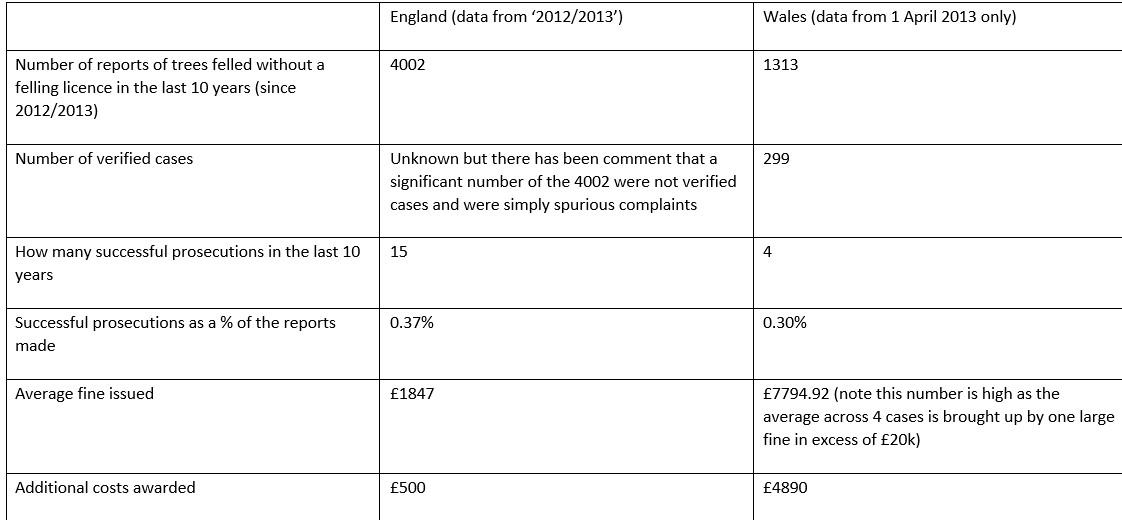The News
Back on 24 November the Guardian newspaper reported into data which had been obtained from the Forestry Commission into illegal felling of trees.
This was England-centric data and I asked those who commented on my post whether they’d be interested in hearing the same data for Wales, by way of a comparison. The answer to that was “heck yeah” so off I went and made a Freedom of Information Act request to Natural Resources Wales (who manage the equivalent of the Forestry Commission’s remit in Wales). The results of that FOIA request are now in.
Before I get on to the results and the comparison, a quick point on what constitutes the illegal felling that I am talking about here. Illegal felling of tree information from the FC relates to trees which were removed without a required felling licence. So the first question we should ask is, when is a felling licence required?
This was England-centric data and I asked those who commented on my post whether they’d be interested in hearing the same data for Wales, by way of a comparison. The answer to that was “heck yeah” so off I went and made a Freedom of Information Act request to Natural Resources Wales (who manage the equivalent of the Forestry Commission’s remit in Wales). The results of that FOIA request are now in.
Before I get on to the results and the comparison, a quick point on what constitutes the illegal felling that I am talking about here. Illegal felling of tree information from the FC relates to trees which were removed without a required felling licence. So the first question we should ask is, when is a felling licence required?
When is a felling licence required?
Both in England and Wales a felling licence is required when trees are being removed in all situations other than the following exemptions:
Trees being felled in inner London
Tree is a sapling or small trees
Orchard trees
Private garden trees
Churchyard trees
Trees in a public open space
Removal in small quantities, less than 5 cubic metres of timber felled per calendar quarter
Trees need to be removed to prevent danger
Trees to be felled to prevent or abate a nuisance (note to my subsidence followers, this exemption could apply to tree root subsidence cases)
Felling authorised under other procedures
Felling by statutory undertakers (e.g., electricity and telecoms) and other public bodies
Felling is in accordance with a scheme already agreed by the Forestry Commission/NRW
The Guardian Stats
The Guardian article flagged up some shocking statistics due to how small the numbers were. It was reported that the FOIA request made to the Forestry Commission had showed that, in the last 10 years fewer than 1% of illegal felling cases in England had resulted in a conviction of the perpetrator.
Drilling down into the data further it set out that 4002 reports had been made of illegally felled trees and, of those, 15 had resulted in a conviction with an average fine issued of £1847.
The take-away from this was that these figures seemed to show both that the Forestry Commission was not pursuing a prosecution in lots of situations and also that, where they did pursue one, the financial penalty of the wrong doing was so insignificant as to have no effect as a deterrent to future wrongdoers. Where illegal felling often goes ahead it’s carried out for the development of land with such a financial benefit that fines such as these can be easily built into development budgets.
Drilling down into the data further it set out that 4002 reports had been made of illegally felled trees and, of those, 15 had resulted in a conviction with an average fine issued of £1847.
The take-away from this was that these figures seemed to show both that the Forestry Commission was not pursuing a prosecution in lots of situations and also that, where they did pursue one, the financial penalty of the wrong doing was so insignificant as to have no effect as a deterrent to future wrongdoers. Where illegal felling often goes ahead it’s carried out for the development of land with such a financial benefit that fines such as these can be easily built into development budgets.
The Wales Stats
So the FOIA results arrived earlier this month and they make for an interesting comparison. The interesting point here being that the % of successful prosecutions in Wales and England are almost identical, at around 0.3% of those claims reported.

How accurate is the figure?
What the FOIA results give us for both the FC and NRW is the number of prosecutions as against the number of reports of illegal felling that are made. The FC has commented that not all reports made to them were verified so this percentage is incorrectly low. NRW provide both the number of report cases (1313) and the number of verified cases (299). So, whilst the % of prosecutions in Wales also look to be under 1%, when calculated against the verified cases, this figure goes up to 1.3%.
The difference between England and Wales seems to be most notably in relation to the value of the fines imposed on conviction. Wales’ average fine being £7700 when compared with England’s figure of £1800.
The difference between England and Wales seems to be most notably in relation to the value of the fines imposed on conviction. Wales’ average fine being £7700 when compared with England’s figure of £1800.
My conclusions
So what have I concluded from carrying out the FOIA request and comparing England’s data from Wales’ data?
In short I have concluded that the situation across both countries is the same. Number of convictions in Wales and England are so low that it is difficult to reach any firm conclusions on location and fine level as the numbers are too small to be able to reach conclusions on any patterns.
What this data does show though, and this can’t be denied, is the low number of convictions made for illegal felling and the modest fines imposed across the UK. Whilst you could hope this is because illegal tree felling is being caught and prosecuted by other methods, e.g., breach of planning law (TPOs) and criminal damage but I am doubtful that this is the case.
In order to hit tree retention targets across the UK it is, in my opinion , imperative that prosecutions are pursued robustly by the FC and NRW for illegal felling and that the outcome of such prosecutions are publicised as a deterrent for the future.
Ultimately though, it’s not until fines hit the perpetrator in the pocket and adversely affect things such as land development profit that I think a difference will really be made.
In short I have concluded that the situation across both countries is the same. Number of convictions in Wales and England are so low that it is difficult to reach any firm conclusions on location and fine level as the numbers are too small to be able to reach conclusions on any patterns.
What this data does show though, and this can’t be denied, is the low number of convictions made for illegal felling and the modest fines imposed across the UK. Whilst you could hope this is because illegal tree felling is being caught and prosecuted by other methods, e.g., breach of planning law (TPOs) and criminal damage but I am doubtful that this is the case.
In order to hit tree retention targets across the UK it is, in my opinion , imperative that prosecutions are pursued robustly by the FC and NRW for illegal felling and that the outcome of such prosecutions are publicised as a deterrent for the future.
Ultimately though, it’s not until fines hit the perpetrator in the pocket and adversely affect things such as land development profit that I think a difference will really be made.



